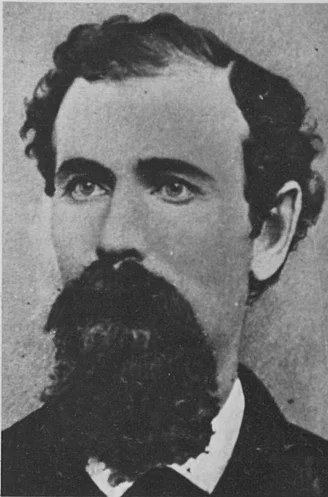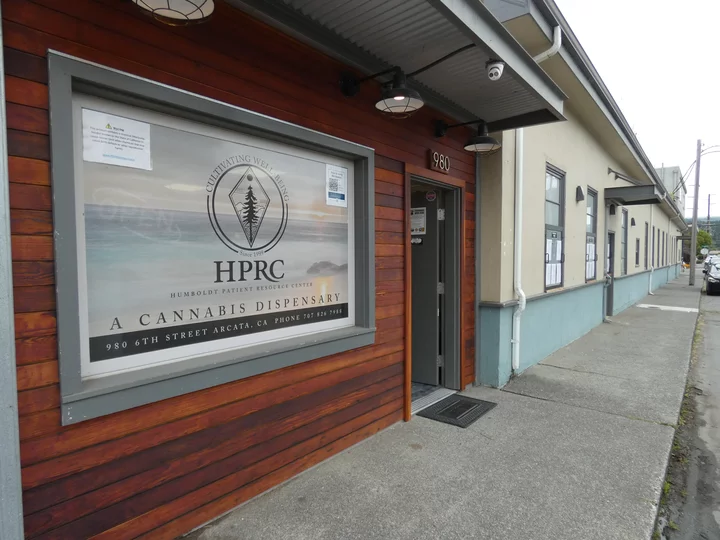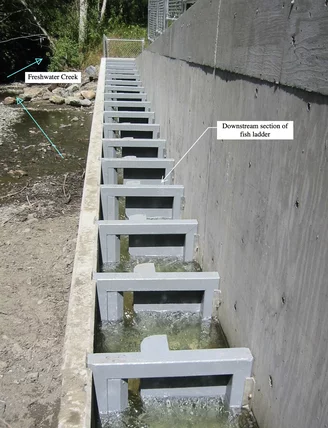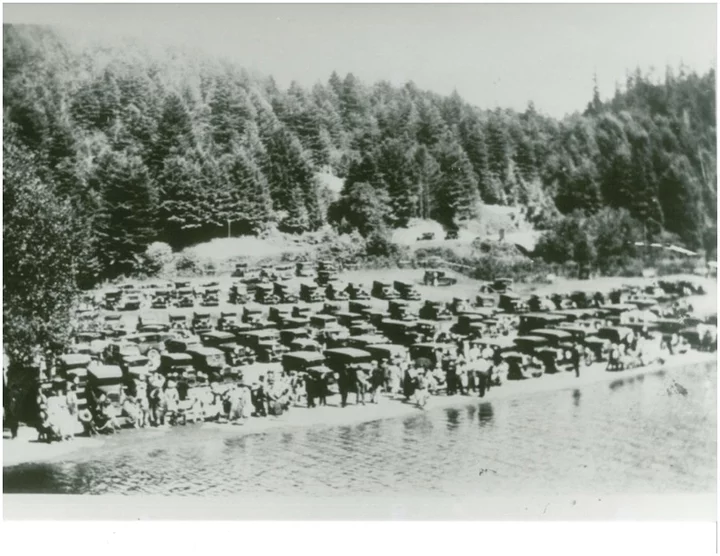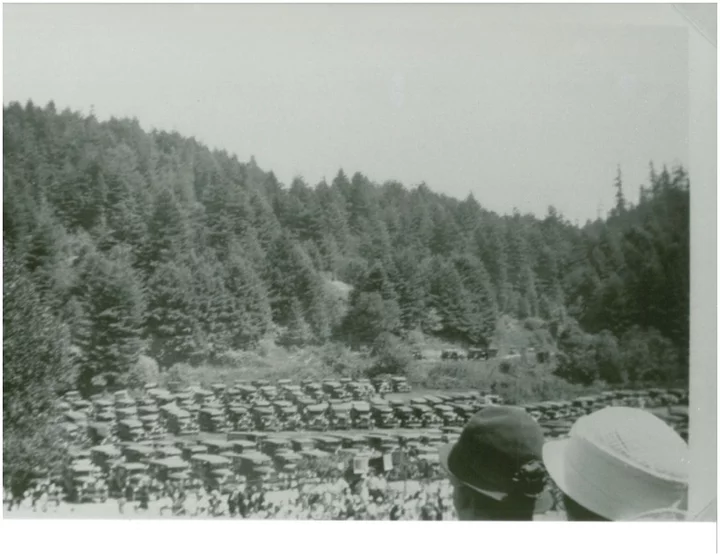THE ECONEWS REPORT:A Trip Back in Time to the Ghost Forest, With Author and Redwood Summer Veteran Greg King
The EcoNews Report / Saturday, June 3, 2023 @ 10 a.m. / Environment
It would seem unbelievable if it weren’t true. EarthFirst!, bombs, crooked cops, racists. This is the story of the redwoods, or rather, the fight to protect the redwoods, as told by one of the partisans of this fight, Greg King. King’s new book, The Ghost Forest: Racists, Radicals and Real Estate in the California Redwoods is part memoir of his own time as fiery young radical in the Redwood Wars and part of history of the economic and social history that set the stage for the Redwood Wars.
Greg joins the EcoNews to talk about his new book. Join us.
Read an excerpt of The Ghost Forest here. The Ghost Forest will be released on June 6th, preorder a copy today.
AUDIO:
“The EcoNews Report,” June 3, 2023.
[Sorry, no transcript this week.]
BOOKED
Today: 8 felonies, 11 misdemeanors, 0 infractions
JUDGED
Humboldt County Superior Court Calendar: Today
CHP REPORTS
US101 N / MAIN ST ONR (HM office): Trfc Collision-Minor Inj
7400 Mm101 N Hum 74.00 (HM office): Assist with Construction
ELSEWHERE
Governor’s Office: Governor Newsom, First Partner join LA fire survivors Jude and Rebecca Kessler for 94th annual Capitol Tree lighting ceremony
RHBB: Power Outage for 183 Customers in Covelo After Acura Crashes into Utility Pole
Governor’s Office: Governor Newsom creates new housing and transportation using nearly $1 billion paid by big polluters
HUMBOLDT HISTORY: Back Before They Knew Any Better, Some Early White Settlers Thought They Could Build With Brick. So Some Became Brick-Makers
Glen Nash / Saturday, June 3, 2023 @ 7:15 a.m. / History
The manufacturing of bricks was an established industry in Humboldt County from the year 1855, as a growing need for them developed to supply the construction trade.
It was expensive to order the heavy product shipped to the North Coast, so local means of production was sought. It was found that clay of good quality was in abundance throughout Humboldt County.
The brick made in Humboldt County was the common red brick. It was used in the building of walls, fireplaces and chimneys. The principal material used in the making of brick is the clay. It contains sand and small quantities of iron, magnesia, lime, potash and other minerals. Each of these substances has an effect upon the color, hardness and durability of the finished brick.
In the early days, Humboldt bricks were made by hand; the clay was mixed with water in a pug mill, sometimes with a horse and a turnstile to operate it. The clay was then placed in molds, pressed and removed from the molds and laid in the sun to dry or placed under cover for a few days. They were then stacked in a kiln and fired.
As soon as machinery could be brought into Humboldt County nearly all bricks were made much easier and much faster using the stiff mud process. In this process, the clay was thoroughly ground and water added to make a stiff mud. After the mud was mixed in a pug mill, it was placed in a machine having a die or opening the exact size of the brick.
This machine, with a large screw, forced a continuous bar of clay through the die. As it emerged it was cut into bricks by a series of steel wires like a cheese cutter, slicing about 12 bricks at a time.
The soft bricks were placed on a pallet holding about 84 bricks each; they were then put in a drying shed with open sides and dried for a considerable length of time, sometimes for thirty days. Next, they were moved and stacked in the kiln, which is like a large oven. The bricks were spaced to allow the heat to circulate around them. These kilns held from 60,000 bricks, or more, at one time, depending on the size of the kiln. A slow heat was applied using wood for about three or four days. Then the oil burners were turned on. About 12 burners, spaced around the bottom of the kiln, brought the temperature to 1900 degrees and it was held at that level for three days, or when the operator determined the firing was complete. The burners were shut off and the kiln allowed to cool slowly.
When the bricks cooled they were removed from the kiln and graded according to color, hardness, straightness and quality and stacked on pallets. The bricks that were too close to the burners were called clinkers and deemed not suitable for most work. The bulk of the bricks were ideal but some, too far from the heat, tended to he a little softer. It was not until 1891 that brickyards introduced facilities for making drain tile. The drain tiles were made in much the same manner except for a different die. The clay used was the same. The tiles were made in various sizes from three-inch in diameter to 10 inches, and were all 12 inches in length.
There are other kinds of brick which had to be shipped into Humboldt such as face brick, pressed brick, fire brick, glazed brick, paving brick and hollow brick, to name a few.
The size of most common brick is 2 1/4 inches thick, 3 3/4 inches wide, and 8 inches long; this size varies in different locations. The weight of a common brick is about 4 1/2 pounds. During the period of time from 1870 to 1930, the local bricks were used in many buildings, such as the Carson building which housed the Ingomar Theater, the Eagles building on Fifth Street, the Carnegie Library, the old county jail and many other buildings in lower downtown which are still standing. Brick was used for foundations in many of the old Victorian homes.
In the years 1880 to 1900, there were six major producing brickyards in Humboldt County. In 1891 the first tile machine came to the area for a brickyard near Rohnerville, west of the railroad. This yard was owned by James D. Thompson, who later sold out and moved his operations. He purchased the brickyard on the Eureka Slough, at the north end of John Hill Road, from John E. Hill who started the yard. Hill was the father of Arthur W. Hill, former district attorney for Humboldt County, and grandfather of Arthur W. Hill, attorney.
Sometime during the early 1900s, James D. Thompson leased the brickyard to John A. Porter, and he changed the name to Eureka Brick and Tile Co. During this time Porter had a man working for him at the brickyard called, “Andy Bear.” The reason for the name? He had a pet bear chained at the brickyard. Later James Thompson again took over the operation.
In 1890, John B. Hill, a cousin of the former Hill, purchased ten acres at 1900 Harrison Avenue, just north of the county hospital, and built a brickyard which he operated for two years with his brother, William. He operated it by himself for twelve more years. In 1904, he closed the brickyard and started raising strawberries on the land. He had built a fine home at 1904 Harrison Avenue. Here, he raised seven children, among them a daughter, Edith, who married Peter McRae, a grocer. A son, Wesley, was at the Eureka Post Office for years, and a son. Warren, was with the Western States Gas and Electric Co. when he was accidentally electrocuted. Another son, Chester, was a shingle weaver in Eureka.
Getting back to brickyards, there was one in Arcata, one in Fields Landing and one just south of Harris Street between Williams and D streets in Eureka. This yard was owned and operated by Jesse N. Lentell, a civil engineer. He served as Eureka city engineer for eleven years and lived near the brickyard at 3120 D Street. The brickyard operated from 1887 to 1915. Elzie Daily located a brickyard in Arcata, on property north of 14th Street and between L and M streets. Block No. 292. This yard furnished bricks for many Arcata buildings including the John Hill built this home at 1904 Harrison Ave. The brickyard was Jacoby Building. The building, now owned by Brizard’s, stands just south of the plaza. (This information was published in the Arcata Union in 1956, and was given to me by Mrs. Martha Roscoe.)
James D. Thompson operated his brick and tile yard on the Eureka Slough, employing about ten men most of the time, and turned out many thousands of bricks and tile until the 1930s. After this period, lots of other material came on the market and the railroad and trucks hauled bricks in from the south. This was the last brickyard left in Humboldt County.
In 1946, Thompson met a young man and sold him the brickyard, staying with him for a few months to teach him the trade. This young man was Henry Hindley. Hindley and his wife, Lorene, continued to operate the business until 1956. After the earthquake of 1954, which damaged m.any chimneys, there was a demand for a good many common bricks. Together, they fired the last kilns of bricks to be fired in Humboldt County, turning out over 120,000, which they quickly sold. Their brick machinery was very old and obsolete and there was too much outside competition. So, they decided to close shop and tear down the plant. They still live on the original site in their nice brick home built from their own bricks.
During the year 1884, when it was decided to build a new Humboldt County courthouse, a brick mason by the name of John Depew, who lived at 1217 Bay Street, could see that many bricks would be needed in this construction. So, he located some suitable clay for brick. The site was at the south end of the present-day Cooper Gulch near 14th Street. Here he built a brickyard and kiln, dug a well for water and turned out many thousands of bricks used in the construction of the new courthouse.
The first bricks were laid there on May 29, 1885, and the cornerstone was laid by members of Humboldt Lodge #79 F. & A.M. on July 4, 1885, along with a very large celebration. In 1954, an earthquake damaged the old courthouse beyond repair, and after seventy years of service it was demolished. Many thousands of the bricks were cleaned and salvaged and have since been used for building faces, fireplaces and other projects in the Eureka area. Thousands of these old bricks were not usable so were hauled and dumped as fill in the same location where they were made in the gulch near 14th Street.
Some idea of the size of the brick industry in Humboldt County is shown in production figures for the years 1890-1893. During this period, the brickyards employed 42 men and produced approximately 4,480,000 bricks and 17,000 yards of drain tile. This material was sold for use in the county.
OBITUARY: Sharon (Sager) Hopkins, 1942-2023
LoCO Staff / Saturday, June 3, 2023 @ 6:56 a.m. / Obits
Sharon (Sager) Hopkins, 81, passed away peacefully March 2 in Salem, Oregon. She was preceded in death by husband, Meriel Hopkins. One of six children of John and Imogene Sager, Sharon was born January 9, 1942 in Eureka. While living in Miranda, her favorite schoolteacher was Mr. Mario Machi, author of Under the Rising Sun, which included his experience in the Bataan Death March. She was a class officer in high school.
Sharon was a housewife for 20 years, an accomplished cook and seamstress. She sewed clothing for herself and her children, including fun Halloween costumes. Sharon was a league bowler whose trophies were always on display in her home.
She later worked as a waitress, most notably at the Angelina Inn in Fernbridge, until retirement. She and husband “Hoppy” loved to hunt. They had his and her mounted bear skins where they lived in “the cabin” on the Van Duzen River in Carlotta.
A longtime member of the New Horizon Church in Salem, she especially enjoyed being part of the Lady’s Group. “She was such a special lady to us, and her cornbread pudding was always a big hit at potlucks.”
Sharon is survived by brothers Harry, Gary and David Sager, daughter Cheri Spring, son Larry Ridenour, three grandchildren and one great grandchild.
A graveside service is scheduled at Ocean View Cemetery in Eureka on June 16 at 11 a.m.
###
The obituary above was submitted on behalf of Sharon Hopkins’ loved ones. The Lost Coast Outpost runs obituaries of Humboldt County residents at no charge. See guidelines here. Email news@lostcoastoutpost.com.
HUMBOLDT TODAY with John Kennedy O’Connor | June 2, 2023
LoCO Staff / Friday, June 2, 2023 @ 4:38 p.m. / Humboldt Today
Catch up quick with the LoCO’s local newscast! Press play above and check below for today’s pressing poll question.
FURTHER READING:
- CONVERSATIONS: Get Your Lightsabers Ready, Star Wars Nerds! The Forest Moon Festival is Coming to the Region This Weekend and Film Commissioner Cassandra Hesseltine is Here to Tell Us All About it
- Bidding on Del Norte’s Tiny House Starts Today; Studen-Led Tours Will Be Held This Weekend
- Del Norte’s Smoke-Free Multi-Unit Housing Ordinance Takes Effect in July
Local Weed Dispensary Humboldt Patient Resource Center Closes Suddenly Following Owner’s Death
LoCO Staff / Friday, June 2, 2023 @ 4:03 p.m. / Business , Cannabis
The HPRC dispensary in Arcata. | Image via company website.
###
The Humboldt Patient Resource Center, a local cannabis dispensary that had been in business for nearly a quarter of a century (mostly in Arcata, briefly in Eureka), posted the following statement on social media on Thursday:
It is with profound sadness that we announce the closure of Humboldt Patient Resource Center Inc. on June 1st, 2023. The untimely and unexpected passing of the owner has presented us with unavoidable challenges concerning our state cannabis license.
For an incredible span of 24 years, we have had the privilege of serving our cherished customers and the community at large. We have strived tirelessly to avoid this unfortunate closure, endeavoring to continue providing the same level of service that has defined our establishment for so many years.
We would like to extend our heartfelt appreciation to each and every individual who has been part of the Humboldt Patient Resource Center family. Your unwavering love and support have been the cornerstone of our success. We are profoundly grateful for the trust you have placed in us and the relationships we have cultivated along the way.
While we navigate this difficult period, we ask for your understanding and patience. Our team is dedicated to working diligently to address the challenges we face and explore all possible avenues to continue serving our community. Your support and encouragement during this time mean the world to us.
As we reflect on the memories we have shared and the connections we have forged, we express our deepest gratitude for your loyalty. It is through your support that we have been able to contribute to the well-being of our community for so many years.
Thank you for being an integral part of the Humboldt Patient Resource Center journey. We value your continued support, and though our paths may temporarily diverge, we hope to remain connected in spirit.
Together, we have created something truly special, and for that, we are eternally grateful.
Wishing you all the best, until our paths cross again in the future.
Thank you so much again,
From The HPRC Staff of Cannabis Consultants, Garden & Back of House
Civil Liberties Groups Demand Sheriff’s Office, Other Agencies Stop Sharing License Plate Data With Cops in Anti-Abortion States
Ryan Burns / Friday, June 2, 2023 @ 3:38 p.m. / Government
Many law enforcement agencies now employ Automated Number Plate Recognition (ANPR) or Automated License Plate Reader (ALPR) software. | Creative Commons (CC BY-SA 2.0)
###
Last week, a trio of civil liberties groups sent letters to 71 California police agencies, including the Humboldt County Sheriff’s Office, demanding they immediately stop sharing data from automated license plate readers with law enforcement agencies in other states because, the groups say, “it violates California law and could enable prosecution of abortion seekers and providers elsewhere.”
Automated license plate readers (ALPR) use optical character recognition to “read” license plates, collecting and storing information such as dates, times and a driver’s locations. Law enforcement agencies can also run the acquired plate numbers through various law enforcement databases and alert other agencies when they find a vehicle of interest.
The three civil liberties groups — Electronic Frontier Foundation (EFF), the American Civil Liberties Union of Northern California (ACLU NorCal) and the American Civil Liberties Union of Southern California (ACLU SoCal) — say that a months-long EFF investigation revealed that many California police departments share records of detailed driving profiles out-of-state agencies.
“ALPRs invade people’s privacy and violate the rights of entire communities, as they often are deployed in poor and historically overpoliced areas regardless of crime rates,” EFF Staff Attorney Jennifer Pinsof said in a press release. “Sharing ALPR data with law enforcement in states that criminalize abortion undermines California’s extensive efforts to protect reproductive health privacy.”
The letters sent to law enforcement agencies go into more detail:
Particularly since the Supreme Court’s decision in Dobbs v. Jackson Women’s Health Organization, which overturned Roe v. Wade, ALPR technology and the information it collects is vulnerable to exploitation against people seeking, providing, and facilitating access to abortion. Law enforcement officers in anti-abortion jurisdictions who receive the locations of drivers collected by California-based ALPRs may seek to use that information to monitor abortion clinics and the vehicles seen around them and closely track the movements of abortion seekers and providers. This threatens even those obtaining or providing abortions in California, since several anti-abortion states plan to criminalize and prosecute those who seek or assist in out-of-state abortions.
You can read a sample of the letters issued by clicking here.
According to these civil rights groups, the 71 California agencies that they sent letters to — again, including the HCSO — have shared ALPR data with law enforcement agencies across the country, including ones in states with abortion restrictions, such as Alabama, Idaho, Mississippi, Oklahoma, Tennessee and Texas.
The groups say this practice undermines the state’s efforts to protect reproductive health privacy, specifically, a 2022 law (AB 1242) prohibiting state and local agencies from providing abortion-related information to out-of-state agencies.
Asked to respond to the demand letter, Humboldt County Sheriff’s Office Public Information Specialist Samantha Karges emailed a statement, saying that while only one of the agency’s patrol vehicles is currently equipped with ALPR equipment and technology, it’s an important tool.
“ALPR assists law enforcement agencies in working together to solve crime, because as we know, crime is not confined within jurisdictional boundaries,” Karges’s statement says. “ALPR allows us to partner with out-of-county law enforcement agencies to combat criminal activity, creating a safer community for all.”
While the agency’s use of this technology is limited thus far, Karges says it may soon expand.
“HCSO conducted a test and evaluation of the ALPR equipment over the last year, with three deputies trained and authorized to utilize the technology,” she writes in the statement. “The testing and evaluation ended at the beginning of this year and is being reviewed by Administrative staff for improvements and next steps prior to full implementation.”
She adds that, in compliance with the California Values Act, this data is not shared with federal law enforcement agencies tasked with immigration enforcement.
The civil liberties groups have given law enforcement agencies a deadline of June 15 to comply and respond.
Get Your Swimming Trunks and Sunscreen! Freshwater Park’s Iconic Swimming Hole is Coming Back This Summer
Isabella Vanderheiden / Friday, June 2, 2023 @ 2:53 p.m. / Drought , Environment , Fish
The Freshwater Park swimming hole. | Photos provided by the Humboldt County Public Works Department.
This summer, the iconic dam-made swimming hole at Freshwater Park will welcome visitors for the first time in three years. If everything goes according to plan, the pool will be ready to accommodate swimmers next month.
There was a host of logistical issues that contributed to the extended closure of the beloved Freshwater Creek pool, including expired permits, drought, the COVID-19 pandemic and unfinished research on water flows in the creek. Andrew Bundschuh, the Environmental Permitting and Compliance Manager for the county’s Public Works Department, told the Outpost that the county had hoped to get the permits in place to install the dam’s fish ladder last summer but those plans fell through due to severe drought conditions.
“Several of the regulatory agencies in the county were concerned that the flows in the creek were too low or too minimal to put the dam in,” Bundschuh said. In May of 2022, a month before the traditional dam installation period, water flow had already dropped to two cubic feet per second. “If we blocked even half of the flow, there wouldn’t be enough flow downstream to provide habitat for the juvenile fish.”
The seasonal dam.
In order to reinstall the dam, the county would need to determine the flow threshold at Freshwater Creek and complete a successful review with various federal and state regulatory agencies, including the California Department of Fish and Wildlife, the California Northcoast Regional Water Quality Control Board, the U.S. Army Corps of Engineers and the National Marine Fisheries Service.
“I worked with the regulatory agencies in looking at historical flow data, which a lot of that information was collected at [Professor Emeritus of Fisheries Biology at Cal Poly Humboldt] Terry Roelofs’ stream gage just upstream of the park on his property,” Bundschuh said. “That data was collected mostly by Salmon Forever along with other flow data provided to me by Fish and Wildlife – which spanned 2002-2013 intermittently – but provided enough data to draw a threshold low flow for dam installation that the agencies agreed with.”
The county looked at historical flow range estimates between May and November and found average flows in Freshwater Creek range from 8.0 to 20.0 cubic feet per second in late May and drop as low as 0.5 CFS in late August before ticking back up in early November.
“Using a conservative approach, a threshold minimal flow needed to be flowing downstream during dam installation will be 1.5 CFS,” according to the project’s description. “This means that flows need to be at least 3.0 CFS prior to installation such that 50 [percent] of flows (at least 1.5 CFS) continue downstream during filling of the pool (roughly 2-4 days). After the dam is filled, whatever the flow is upstream of the dam should be the same amount of flow that is continuing downstream via the overspill section of the dam combined with what is flowing through the fish ladder and back into the creek.”
Colin Anderson, a biologist with Fish and Wildlife, worked closely with the county to “define dates and flow restrictions around the dam installation” and reviewed the findings of the flow analysis to ensure the fish that use the creek as a nursery and seasonal habitat are protected throughout the installation process.
“Certain low flow during drought years would prevent the installation and operation of the dam,” Anderson explained in an email to the Outpost. “Anytime federally listed species are present in an area where in-stream work occurs a biological opinion must be created and approved. In Freshwater Creek we have three listed salmonids, Southern Oregon Northern California Coho Salmon, California Coastal Chinook Salmon, and Northern California steelhead trout.”
A small section of the stream channel will be disturbed during the dam installation process, which is expected to begin in about two weeks. The county will do a little bit of grading to accommodate a crane that will be used to install the flashboards for the dam. Workers will also have to go in and clean out the fish ladder, which often fills up with mud and silt during the winter months.
Simultaneously, the fish will be removed and relocated to an adjacent habitat, Anderson explained. “This is a common practice anytime disturbance inside the stream channel occurs for restoration and construction projects,” he said. “We plan to use seine nets as a first method and switch to electrofishing if necessary.”
“Electrofishing” is a method used by the U.S. Fish and Wildlife Service to temporarily stun fish and other aquatic animals with electricity in order to sample or remove them from specific areas. When performed correctly, electrofishing results in no permanent harm to the fish, which will typically resume swimming about two minutes after being caught.
Once the dam is in place – hopefully by June 25 – the creek will slowly fill the pool, providing deep, cold water ideal for salmonids.
“Large pools are often preferred habitat for Coho salmon,” Anderson said. “In streams that lack large pools or off-channel habitat, restorationists construct this habitat for Coho and other salmonids. We have collected data in many of these habitat restoration projects locally … and found that growth and survival of Coho can be greater than in the creek environment. The large pool formed by the Freshwater Dam may mimic some of these habitats and could provide high-quality habitat for growth and survival.”
Depending on water flows, the pool should be filled by the beginning of July. “The brave kids that can handle the cold will be freezing their toes off swimming in the pool before the Fourth of July,” Bundschuh said.
Freshwater Park’s iconic swimming hole has been sorely missed by Pal Camp attendees in recent years. Stephanie Carter, executive director of the Redwood Discovery Museum which hosts Pal Camp, said the kids have had to make do with other water activities.
“Freshwater Park’s swimming hole has been a part of Pal Camp for almost the entirety of the camp’s 72-year run,” Carter wrote in an email to the Outpost. “The dam’s absence the past few years has had an impact on our campers’ experience, but we made do by substituting our swim days with water play activities every week. The return of the dam means the return of a long-time Pal Camp tradition, and we are so excited to give our campers the full Pal Camp experience again!”
If you’ve ever wondered what the swimming hole may have looked like in the 1930s or the 1950s, respectively, keep scrolling for some cool shots of old-timey cars and synchronized swimming events at Freshwater Park, courtesy of Bundschuh and the Public Works Department.
###


